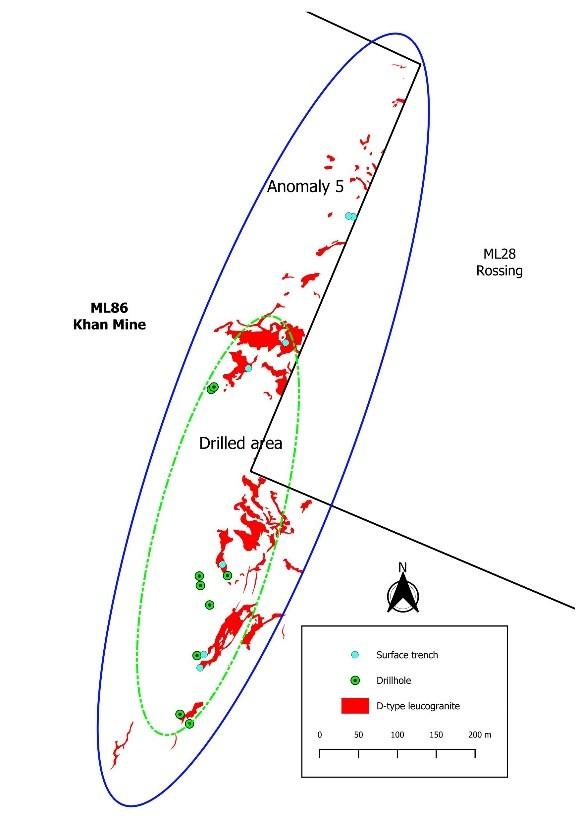Madison Metals (CSE:GREN) (OTCQB:MMTLF) jhas announced that results from the maiden drill program at the Khan Uranium Project have confirmed subsurface zones of uranium, aligning with high-grade surface results. The Khan Uranium Project, located in the Erongo Uranium Province, Namibia, has shown promising potential, prompting the Company to plan a new and extensive Phase II drilling program to further define and expand the uranium resource.
During the maiden drill program, nine Reverse Circulation (RC) drill holes were completed, totaling 997 meters. This drilling aimed to confirm the subsurface continuation of anomalous surface radiometric readings and trench sampling assays. The drill program covered only the southern portion of Anomaly 5, with the northern portion remaining undrilled due to accessibility challenges. The northern portion had previously returned a 1-meter interval of 84,700 ppm from KM5TR006.
The Company provided a map illustrating the drilled southern portion and the undrilled northern portion of Anomaly 5. Elevated radioactivity was intersected in all drill holes except KM5RC002. However, KM5RC004 deviated excessively and did not reach the intended target. The Company plans to redrill this hole in the next phase. Of the nine drill holes, seven were gamma probed using the Gamma Ray Spectrometer 1128. KM5RC003 collapsed at 22 meters, and KM5RC006 collapsed from the top, preventing probing. Assay results for intervals from these two holes have been received.
The drilling data indicate that target alaskites are hosted within the Khan formation, which consists of calc-silicates, quartzites, and schists. The alaskites appear near vertical and parallel to the Khan formation, with possible stringer occurrences. These alaskites exhibit pinch and swell structures, characteristic of a high-strain zone. The observed geometry of the sheeted leucogranites at Anomaly 5 is en-echelon, suggesting emplacement in a pressure shadow at a brittle-ductile transition.
Exploration results continue to validate the Company’s exploration model at Anomaly 5, where uranium-bearing alaskites are emplaced in a pressure shadow. This model is similar to other significant uranium deposits in the region, including Rossing, Husab, Valencia, and Etango. Madison’s maiden drill program marks a significant step towards a discovery hole for the company. The Khan project shows all key characteristics to host an alaskite-hosted uranium deposit, reinforcing the exploration model’s validity. The Company has identified the location of targeted leucogranites, confirming that surface anomalies extend to the subsurface.
Following a comprehensive review of the exploration data from its maiden drill program, Madison identified inadvertent errors in the hand-held spectrometer U3O8 percentage values reported in a news release dated June 24, 2024. These errors resulted from converting portable spectrometer readings from ppm to percentage, causing a decimal point shift. Madison has taken steps to prevent such issues in the future and regrets any confusion caused by these errors.
Madison’s geology team is using probing and geological data to define the geometry of their targets, guiding future drilling efforts. The upcoming Phase II drilling program aims to better define and expand the uranium resource at the Khan Uranium Project, continuing Madison’s pursuit of significant uranium deposits in Namibia’s Erongo Uranium Province.
Highlights from the results are as follows:
Area Tested: Uranium confirmed by drill testing along 590 metres (m) of a 1,000m mapped area.
Comparison with Other Mines: Intersected grades are comparable to the average U3O8 grades of notable Namibia leucogranite uranium mines: Rossing (330 parts per million) (ppm), Husab (500 ppm), and development deposits including Forsys Metals’ Valencia Main (136ppm), Deep Yellow’s Omahola (190 ppm) and Bannerman’s Etango (220 ppm).
KM5RC001: Found a continuous 21m section with an average of 386 ppmuranium, including a 2m section with 1,982 ppm uranium.
KM5RC003: Lab tests showed a 12m section with 520 ppm uranium, including a 1m section with 2,062 ppm uranium, a 5m section of 663 ppm, including 1m of 1,646 ppm and 5m of 1,675ppm.
KM5RC005: Found a 29m section with 332 ppm uranium, including two 2m sections with 1,259 ppm and 1,384 ppm uranium, respectively.
KM5RC007: Found multiple sections of elevated radioactivity, including 604 ppm uranium over 11m and 1,319 ppm uranium over 3m.
KM5RC008 and KM5RC009: Confirmed that the elevated radioactivity continues south, extending the mineralized area
The above references an opinion and is for information purposes only. It is not intended to be investment advice. Seek a licensed professional for investment advice. The author is not an insider or shareholder of any of the companies mentioned above.
I specialize in the mining industry, focusing on top global mining stocks. My reporting covers the latest industry news, company/project developments, and profiles of key players. With a degree in finance and economics from the University of Toronto, I’ve contributed to a wide range of industry publications. Beyond my professional pursuits, I have a keen interest in global business and a love for travel.
Comments are closed.





